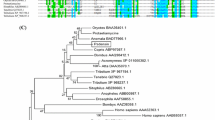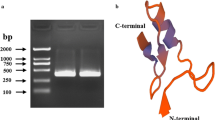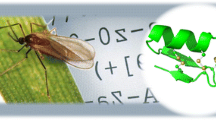Abstract
We have previously identified a defensin-like peptide (BmDp, Genbank accession number DQ118523), in the larvae of a silkworm, Bombyx mori (B. mori) using wdS20658 cDNA in a Bombyx EST database (Silk Base: http://www.ab.a.u-tokyo.ac.jp/silkbase). A full-length of BmDp cDNA was cloned by reverse transcriptase-polymerase chain reaction (RT-PCR) and expressed in Escherichia coli cells in order to obtain a functional peptide. Amino acid sequence comparison of cysteine-rich defensin-like peptides with those of the BmDp showed to be identical protein as BmDefensinA designated as BmdefA gene deposited in the DDBJ database under the accession number AB367525. Sequence alignments revealed that the BmDp belongs to the insect defensin family and is close to galiomicin and spodoptericin, a defensin and a defensin-like protein having antimicrobial activities in phylogenetic analysis. Thus, we evaluated the effect of immune challenge and antimicrobial activity to understand the nature of this anionic BmDp. Semiquantitative RT-PCR analysis showed that BmDp gene expression was inducible by bacterial injection and peaked at a highest level at 8h after bacterial injection. This result suggests that BmDp is related with immune response against bacteria. A purified recombinant GSTBmDp fusion protein did not show direct antimicrobial activity against bacteria and fungi, which is differed from cationic antibacterial insect defensins and neutral antifungal defensin-like peptides.
Similar content being viewed by others
References
Bonmatin JM, Bonnat JL, Gallet X, Vovelle F, Reichhart JM, Hoffmann JA, Keppi E, Legrain M and Achstetter T (1992) Twodimensional1H NMR study of recombinant insect defensin A in water: Resonance assignments, secondary structure and global folding. J. Biomol. NMR 2: 235–256.
Bulet P, Hetru C, Dimarcq JL and Hoffmann D (1999) Antimicrobial peptides in insects; structure and function. Dev. Comp. Immunol. 23: 329–344.
Fehlbaum P, Bulet P, Michaut L, Lagueux M, Broekaert WF, Hetru C and Hoffmann JA (1994) Insect immunity. Septic injury of Drosophila induces the synthesis of a potent antifungal peptide with sequence homology to plant antifungal peptides. J. Biol. Chem. 269:33159–33163.
Gorman MJ, Kankanala P and Kanost MR (2004) Bacterial challenge stimulates innate immune responses in extra-embryonic tissues of tobacco hornworm eggs. Insect Mol. Biol. 13:19–24.
Hanzawa H, Shimada I, Kuzuhara T, Komano H, Kohda D, Inagaki F, Natori S and Arata Y (1990) 1H nuclear magnetic resonance study of the solution conformation of an antibacterial protein, sapecin. FEBS Lett. 269: 413–420.
Hara S and Yamakawa M (1995) Moricin, a novel type of antibacterial peptide isolated from the silkworm, Bombyx mori. J. Biol. Chem. 270:29923–29927.
Kaneko Y, Tanaka H, Ishibashi J, Iwasaki T and Yamakawa M (2008) Gene expression of a novel defensin antimicrobial peptide in the silkworm, Bombyx mori. Biosci. Biotechnol. Biochem. 72:2353–2361.
Katsuma S, Tanaka S, Omuro N, Takabuchi L, Daimon T, Imanishi S, Yamashita S, Iwanaga M, Mita K, Maeda S, Kobayashi M and Shimada T (2005) Novel macula-like virus identified in Bombyx mori cultured cells. J. Virol. 79:5577–5584.
Lamberty M, Ades S, Uttenweiler-Joseph S, Brookhart G, Bushey D, Hoffmann JA and Bulet P (1999) Insect immunity. Isolation from the lepidopteran Heliothis virescens of a novel insect defensin with potent antifungal activity. J. Biol. Chem. 274:9320–9326.
Lamberty M, Caille A, Landon C, Tassin-Moindrot S, Hetru C, Bulet P and Vovelle F (2001) Solution structures of the antifungal heliomicin and a selected variant with both antibacterial and antifungal activities. Biochemistry 40:11995–12003.
Landon C, Sodano P, Hetru C, Hoffmann J and Ptak M (1997) Solution structure of drosomycin, the first inducible antifungal protein from insects. Protein Sci. 6:1878–1884.
Marcus JP, Goulter KC, Green JL, Harrison SJ and Manners JM (1997) Purification, characterisation and cDNA cloning of an antimicrobial peptide from Macadamia integrifolia. Eur. J. Biochem. 244:743–749.
Mercado-Pimentel ME, Jordan NC and Aisemberg GO (2002) Affinity purification of GST fusion proteins for immunohistochemical studies of gene expression. Protein Expr. Purif. 26:260–265.
Schuhmann B, Seitz V, Vilcinskas A and Podsiadlowski L (2003) Cloning and expression of gallerimycin, an antifungal peptide expressed in immune response of greater wax moth larvae, Galleria mellonella. Arch. Insect Biochem. Physiol. 53:125–133.
Ueda K, Saito A, Imamura M, Miura N, Atsumi S, Tabunoki H, Watanabe A, Kitami M and Sato R (2004) Purification and cDNA cloning of luxuriosin, a novel antibacterial peptide with Kunitz domain from the longicorn beetle, Acalolepta luxuriosa. Biochim. Biophys. Acta. 1722:36–42.
Volkoff AN, Rocher J, d’Alencon E, Bouton M, Landais I, Quesada-Moraga E, Vey A, Fournier P, Mita K and Devauchelle G (2003) Characterization and transcriptional profiles of three Spodoptera frugiperda genes encoding cysteine-rich peptides. A new class of defensin-like genes from lepidopteran insects? Gene 319:43–53.
Wen H, Lan X, Cheng T, He N, Shiomi K, Kajiura Z, Zhou Z, Xia Q, Xiang Z and Nakagaki M (2009) Sequence structure and expression pattern of a novel anionic defensin-like gene from silkworm (Bombyx mori). Mol. Biol. Rep. 36:711–716.
Xiong S, Wang YF, Ren XR, Li B, Zhang MY, Luo Y, Zhang L, Xie QL and Su KY (2005) Solubility of disulfide-bonded proteins in the cytoplasm of Escherichia coli and its “oxidizing” mutant. World J. Gastroenterol. 11:1077–1082.
Zhu S, Li W, Jiang D and Zeng X (2000) Evidence for the existence of insect defensin-like peptide in scorpion venom. IUBMB Life. 50:57–61.
Author information
Authors and Affiliations
Corresponding author
Rights and permissions
About this article
Cite this article
Song, KJ., Park, BR., Kim, S.Y. et al. Molecular characterization of anionic defensin-like peptide in immune response of silkworm, Bombyx mori L. (Lepidoptera). Genes Genom 32, 447–453 (2010). https://doi.org/10.1007/s13258-010-0038-1
Received:
Accepted:
Published:
Issue Date:
DOI: https://doi.org/10.1007/s13258-010-0038-1




